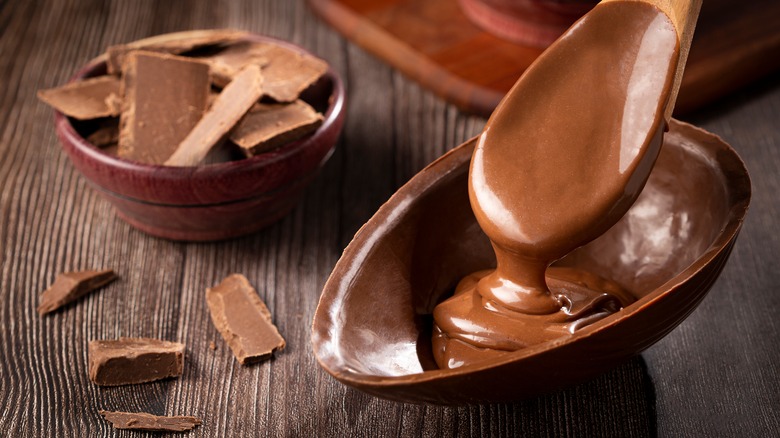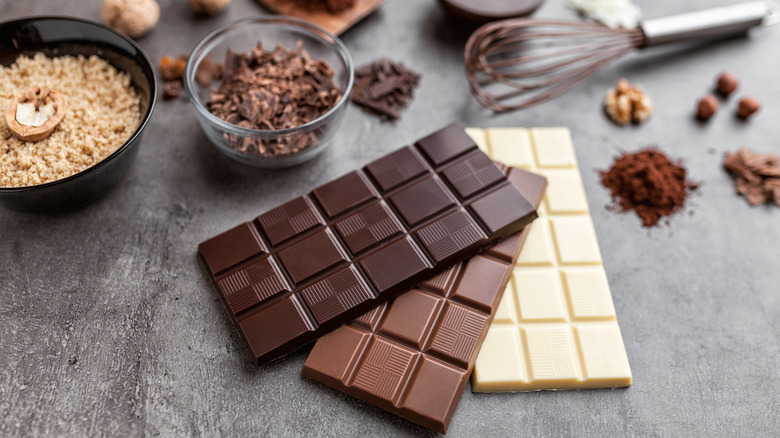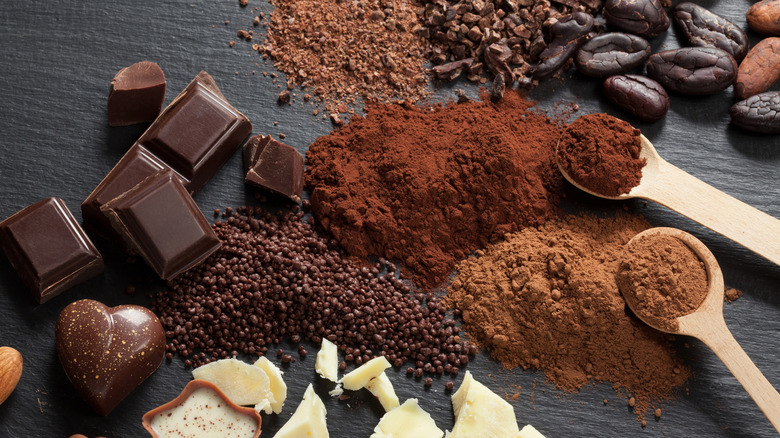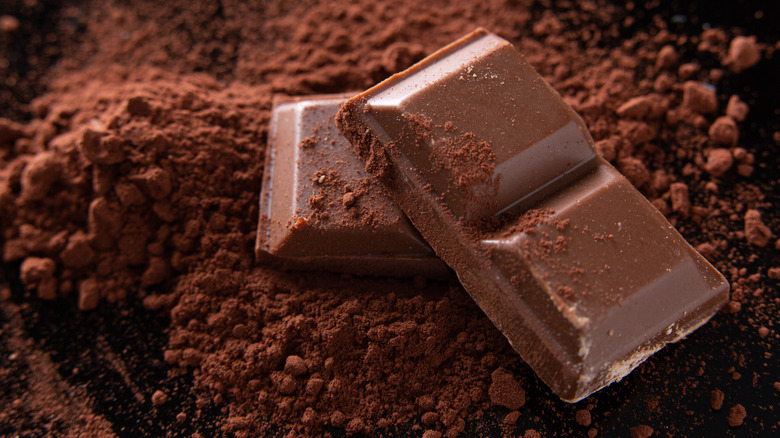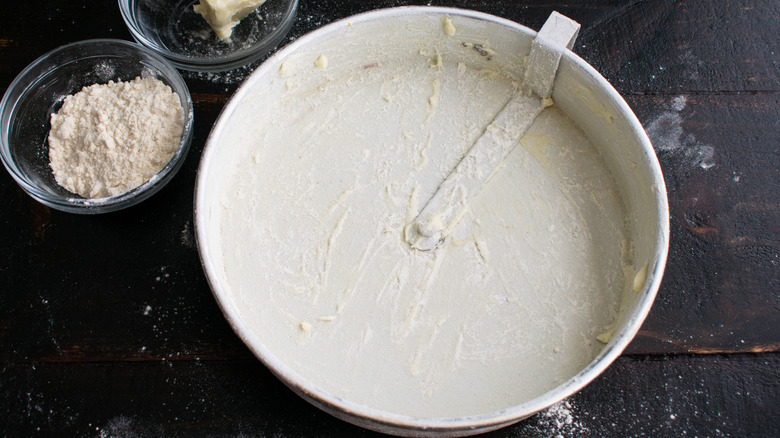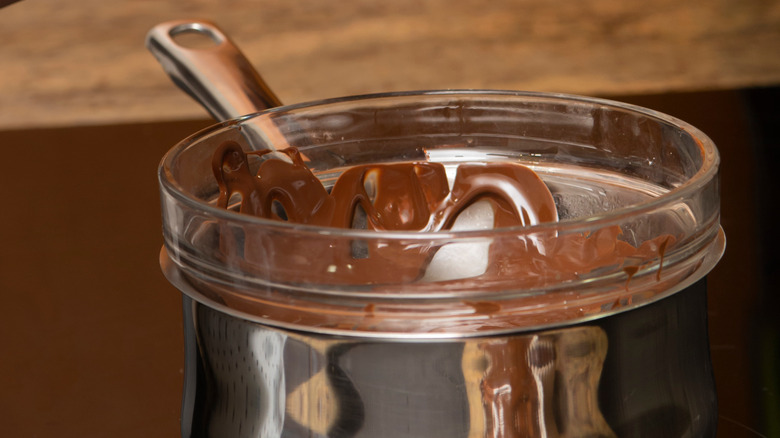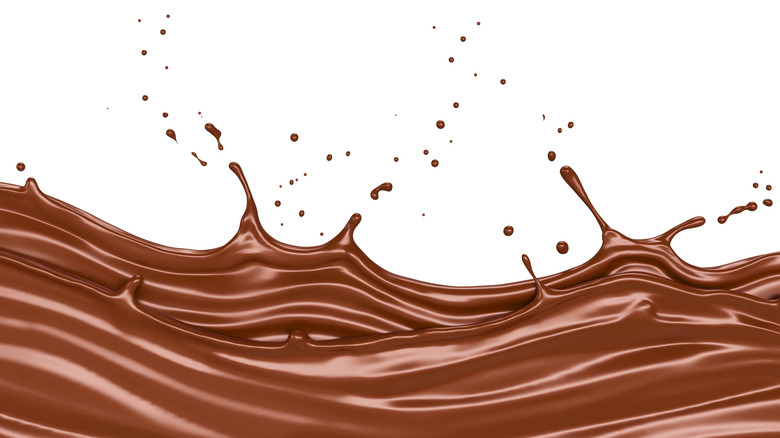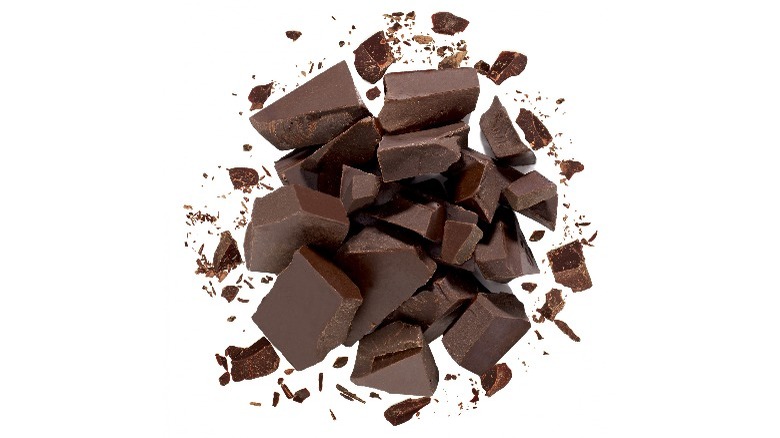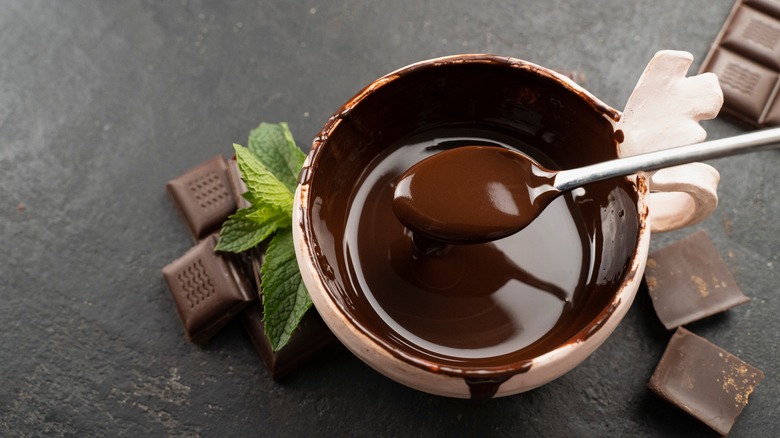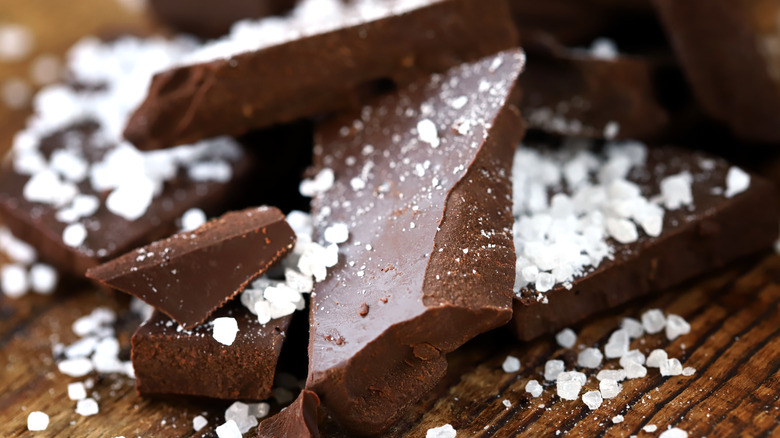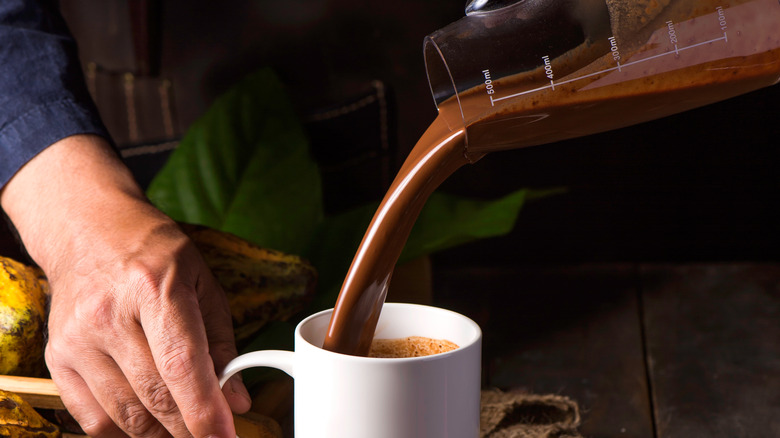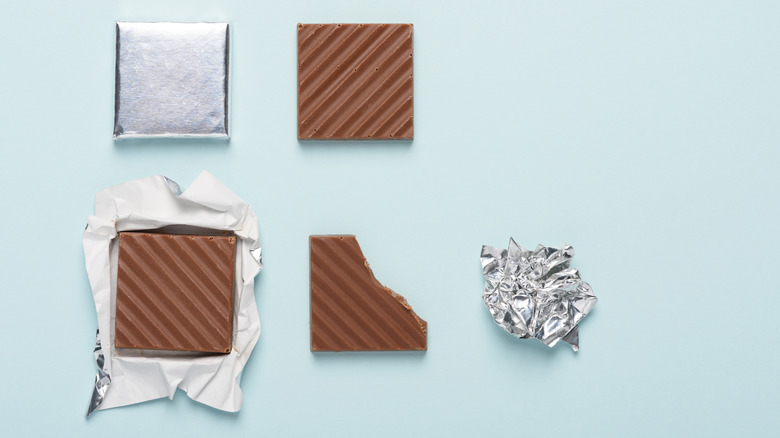11 Mistakes You Need To Avoid When Baking With Chocolate
Chocolate has a hold on us like no other confection. What started as sacred food made from the cacao fruit by the ancient Aztecs, Maya, and Toltecs, has since spread across the globe, delighting tastebuds all over (via Britannica). As a result, the global chocolate confectionery industry is close to $1 trillion and is only expected to increase, according to Statista.
It is no wonder that chocolate is now a staple in any home baker's kitchen. However, the decadent ingredient can be a little finicky to work with. Whether you're using chocolate bars, chips, or cocoa powder, if you want stellar results for all your chocolate baking projects, read on. We have compiled a list of chocolate-baking pitfalls you'll want to avoid the next time a craving strikes you. Whether you're making a classic chocolate chip cookie recipe or a decadent tray of brownies, we will help you churn out the best possible chocolate desserts.
1. Using the wrong kind of chocolate
One of the easiest mistakes you can make with chocolate is also one of the simplest to avoid. It's one thing to categorize chocolate as dark, milk, and white, but it gets more complex. For this reason, you'll want to be careful about the type you are using for a particular baking project.
According to Webstaurant, dark chocolate is made of at least 35% cacao, but the amount can be much higher. Lake Champlain Chocolates explains that the average is closer to 50%, while semi-sweet and bittersweet styles tend to approach 70%. As the percentage of chocolate goes up, so does the bitter chocolate flavor, since the volume of sweetener and milk additives that would mellow the flavor decreases. Meanwhile, as hinted by its name, unsweetened chocolate is not cut with any sugar and is typically used in conjunction with other baked products.
As for milk chocolate, it only has to contain 10% chocolate liquor and the remainder can be cut with sugar and milk products. This makes it smooth, mild, and suitable for confections or drizzling as a finish. However, it may not pack the chocolate punch required for a recipe. Be sure to follow recipe instructions to ensure you are using the correct type of chocolate for your project.
2. Using the wrong cocoa powder
Chocolate consists of two ingredients from the cocoa bean: cocoa butter and cocoa powder. As with solid chocolate, there are more types of cocoa powder than you would think, and using the correct kind helps guarantee successful baked goods. The powder is made by grinding cocoa beans into a liquid state and then pressing out the cocoa butter (via King Arthur Bakes). This process produces natural cocoa powder, such as the one by Hershey's.
Meanwhile, Dutch-processed cocoa powder is made with alkalized cocoa nibs, which makes the cocoa darker. While it provides a more chocolaty flavor, it takes away some of the cocoa's natural fruitiness. Because Dutch cocoa is alkalized, it can react differently with leavening agents such as baking soda and powder when used in baking (via King Arthur Bakes). Finally, black cocoa is further alkalized, turning it very dark and modifying the flavor with its earthy complexity. Make sure to check the ingredient list to be sure you are using the right cocoa powder for the job.
3. Using low-quality chocolate
When it comes to chocolate, it really is a matter of quality over quantity. Consequently, using quality chocolate will vastly improve any recipe. In the United States, dark chocolate must contain at least 35% cacao (per Webstaurant), which results in a considerable range. Plus, you may be surprised to know that many confections sold alongside the good stuff don't actually contain enough cocoa to be considered chocolate, according to the Food & Drug Administration's requirements (via ConsumerAffairs).
While you may think that using lower-quality chocolate for baking will not make a significant difference, The Guardian begs to differ. The outlet spoke with several chocolate and confection experts who explained that fillers like oils used in low-quality chocolate can negatively affect your baking projects. For example, they can fail to melt correctly and ruin a ganache. Instead of using low-quality chocolate from the bakery aisle, experts recommend buying a high-quality bar from the chocolate section.
The University of Illinois Extension suggests using your senses to check the quality. Fine chocolate has a robust chocolaty scent and looks smooth and glossy. If you break off a piece, it should have a crisp hard snap. Most importantly, good chocolate melts easily in your mouth and is velvety, not gritty or waxy.
4. Flouring chocolate cake pans
If you're used to baking cakes, you'll know that the pan should be coated in flour so that the contents can easily release. Los Angeles Times explains that this gives the batter something to stick to rather than the pan itself. Typically, you rub the pan with butter and sprinkle flour to coat the entire surface. However, if you're making a chocolate cake, the flour will stick out like a sore thumb, ruining the aesthetic of the dessert.
Instead of following the traditional method with flour, the Los Angeles Times recommends substituting it with cocoa powder. In addition to avoiding unsightly flour marks, the cocoa powder will add an extra layer of chocolate flavor to the cake. This hack is incredibly useful and can be used with most kinds of cocoa powder. But as one Redditor commented, make sure that whichever style you use is unsweetened, as a sweetened cocoa powder will caramelize in the oven.
5. Overheating chocolate
Chocolate is a sensitive creature and it does not like to get too hot. Per What's Cooking America, it begins to melt at just over 80 F. When heating chocolate for baked goods, it is important not to let it overheat or it may burn or suffer from textural issues.
According to Chocolate Phayanak, chocolate that has been overheated can seize. This is when it becomes lumpy and hard and loses the glossy look you were aiming for. Once this occurs, the chocolate can't be used until it is transformed back into a smooth state. Slowly adding a liquid like water or milk can remedy the situation. Ideally, if you want to avoid this outcome, don't let dark chocolate go above 120 F and keep milk or white chocolate below 110 F.
To melt chocolate without overheating it, Insider recommends microwaving it in 20-second intervals, checking and stirring in between. The second option is to use a double boiler system on low heat. Place water in a saucepan and add the chocolate to a pan or heat-proof bowl on top, stirring every so often until it has fully melted.
6. Letting moisture into your chocolate
Despite the fact that using a double boiler is one of the most effective ways to melt chocolate, it does have its pitfalls. Mainly, your precious chocolate is placed in close contact with water. Water and oil might be a famous pair of opposites, but water and chocolate are a combination that ensures disaster. According to Exploratorium, when chocolate is exposed to even the tiniest amount of water it will seize up and become functionally useless.
Even just a bit of steam creeping inside the top of a double boiler can be enough to ruin what was a perfectly nice bowl of chocolate. To avoid this outcome, the popular chocolate brand Ghirardelli notes that double boilers should not be so hot that they start to boil. Apart from steam, a single drop of water will also cause chocolate to seize. To prevent this, ensure that anything touching the chocolate (including bowls, pans, and utensils) is completely dry before you add the goodies.
7. Not chopping the chocolate
No one likes to add extra steps to the cooking process, but with chocolate, it is worth doing it right. Chopping up larger pieces of chocolate is the best way to guarantee uniform amounts for all your baking needs. As Ghirardelli notes, if the pieces aren't small enough during the melting process, the temperature will be uneven and it will not melt consistently.
While you may be tempted to reach for a bag of chocolate chips, some experts advise against this shortcut and recommend always chopping chocolate from a larger bar. Chocolatier Anne Wolf told Yahoo! Finance that bars tend to contain optimal proportions of ingredients to produce high-quality chocolate. On the other hand, chocolate chips are designed to hold shape not flavor.
Even when you are making baked goods that require small pieces of chocolate, such as chocolate chip cookies, Wolf suggests chopping up a bar instead. To avoid an extensive cleanup when breaking up chocolate, Real Simple recommends lightly warming the chocolate in the microwave and using a serrated knife. This allows the bar to break easily without sending small chocolate shards throughout your kitchen.
8. Not adding fat to melted chocolate
When you are melting chocolate, adding a bit of fat can be helpful in a multitude of ways. First, it provides a smoother consistency and makes the chocolate easier to work with (via How Stuff Works). Additionally, Kitchen Seer notes that adding a little fat will give the chocolate a glossier finish once it hardens. This is good when making glazes or chocolate-dipped confections, which benefit from an aesthetic touch.
The type of fat you use depends on what you intend to do with the chocolate. Butter, oil, or shortening will all work, but make sure that whichever you choose is at room temperature. Cold fat can cause the chocolate to become lumpy and unmanageable — the exact opposite outcome you want.
Adding butter makes chocolate easier to work with if you're incorporating it into a larger baked good like a cake or tray of brownies. In these instances, the flavor of butter is also welcome. Oil can be used to thin out or make chocolate easier to work with if you're using it for dipping. However, you'll want to choose a flavorless option such as canola oil or unflavored shortening to avoid detracting from the chocolate taste.
9. Not salting chocolate
While most people associate chocolate with sweetness, it also requires salt to reach its full potential. According to Royal Wholesale Chocolate, in order to taste sweet flavors we need a bit of opposing saltiness. At the same time, salt helps to counteract the excess sweetness and keep the chocolate flavor balanced. The Academy of Chocolate Arts elaborates that salt helps to reduce bitterness, which tends to be more prominent in dark chocolate.
A single pinch of salt is enough to bring out all these benefits. Since salt does not melt when sprinkled on top or incorporated into a chocolaty recipe, using just a little will allow the flavor to distribute without giving off an overtly salty taste. As The Chocolate Journalist notes, using salt is a good way to improve lackluster chocolate by adding an element of flavor and enhancing the overall result. Plus, if you opt for coarse salt, you'll get a pleasant textural bonus too.
10. Not blooming your cocoa powder
Cocoa powder can often benefit from being mixed with wet ingredients in a process called blooming (via The University of Wyoming Extension). When the powder combines with a liquid, it dissolves and releases a more intense chocolaty flavor. When the bloomed cocoa powder is added to the rest of the ingredients, the chocolate flavor is ultimately more complex and satisfying.
For successful results, mix the cocoa powder with warm liquid until it has fully dissolved, stirring until you form a smooth paste with no lumps. You're best off blooming the cocoa at the beginning of the baking process to give the mixture time to cool while you prepare the rest of the recipe.
Although many recipes don't explicitly include blooming as a step, if the instructions call for enough liquid or fat (milk, water, coffee, oil, or melted butter are popular options), then you'll want to take the extra time required to bloom the cocoa powder and release its full potential.
11. Storing it incorrectly
Even if you buy the best chocolate available, if you are storing it incorrectly then you may find that it doesn't perform as you would expect. While you may be tempted to put chocolate in the fridge, resist the temptation. As Read Cacao notes, chocolate is shelf stable at room temperature but does not like extreme heat or cold. If it's stored in the fridge, it will attract moisture once you take it out. In turn, it will cause white sugar spots to appear on the chocolate's surface, affecting the taste and texture.
Additionally, chocolate is porous and absorbs the flavors of whatever is in proximity. Be sure to avoid storing it next to anything especially aromatic such as smelly cheese, onions, or fish. Your best bet is to store your chocolate in an airtight container somewhere cool and dark that has a consistent temperature. If stored correctly, Lake Champlain Chocolates notes that milk chocolate can keep for around a year, while dark chocolate will stay fresh for up to two years.
